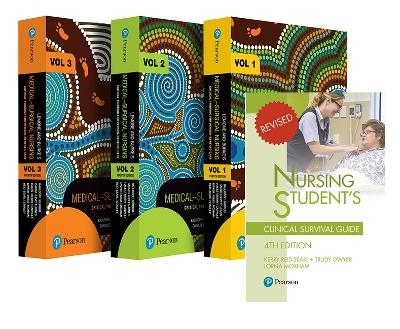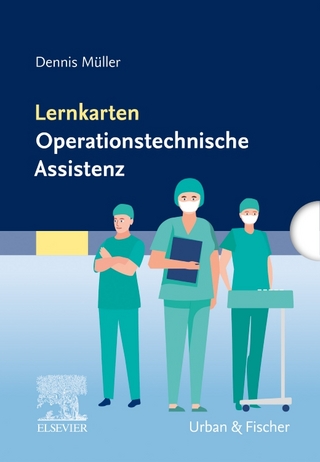
LeMone and Burke's Medical-Surgical Nursing
Pearson
978-0-6557-9880-4 (ISBN)
- Titel nicht im Sortiment
- Artikel merken
LeMone and Burke's Medical-Surgical Nursing: Critical Thinking for Person-Centred Care
Provides a comprehensive, contemporary and consistent systems-based approach that engages students and provides the practical knowledge and skills they need to care for adult patients with a focus on person-centred, holistic nursing care.
Designed to:
emphasise a person-centred philosophy whereby the person who is the recipient of care is seen as an integral member of the team and consideration of their needs and wishes is paramount
foster critical thinking and clinical reasoning skills as the basis for safe clinical practice and nursing excellence
recognise the nurse's role as an essential member of the inter-professional healthcare team.
Nursing Student's Clinical Survival Guide
This quick-reference guide is not rivalled by anything else in the market. As a support text, Reid-Searl's Nursing Student's Clinical Survival Guide assists students with tips to competently conduct clinical skills for safe and person-centred care in clinical settings.
Whether used individually across students' education and into early practice, or as a tool to complement a comprehensive text such as Berman, Skills in Clinical Nursing, Clinical Survival Guide students to deliver competent person-centred care in professional practice.
Samples LeMone and Burke's Medical-Surgical Nursing: Critical Thinking for Person-Centred Care
Download the detailed table of contents from LeMone and Burke's Medical-Surgical Nursing: Critical Thinking for Person-Centred Care >
Preview a sample chapter from LeMone and Burke's Medical-Surgical Nursing: Critical Thinking for Person-Centred Care >
Nursing Student's Clinical Survival Guide
Download the table of contents and sample pages from Nursing Student's Clinical Survival Guide
Tracy Levett-Jones is a Distinguished Professor and Head of School in the School of Nursing & Midwifery at the University of Technology Sydney. Her program of research focuses on patient safety, empathy, belongingness, clinical reasoning, and simulation. Professor Trudy Dwyer is a Research Intensive Academic at CQUniversity and Visiting Research Fellow with Central Queensland Health and Hospital Service. With a background in critical care nursing, she has extensive experience coordinating undergraduate courses/programs, curriculum development and research higher-degree supervision. Professor Lorna Moxham started nursing in 1980 and is a 3-year specialist hospital-trained psychiatric nurse. Lorna is passionate about the nursing profession, particularly mental health nursing, and is actively contributing at regional, state, national and international levels. Kerry Reid-Searl is currently a Professor of Innovation and Simulation in the School of Nursing and Midwifery at the University of Tasmania. Kerry has been involved in nursing education for more than 30 years and over this time she has remained clinically current. Her research interests include patient safety, simulation, paediatrics and wound care. Kamaree Houlis-Berry's career spans more than 25 years and commenced with the Australian Army where she trained as a medic and then became a nursing officer at the rank of lieutenant. She has been employed in the public, private and academic sectors in a number of roles, and is now Founder and Director of her own advisory and consulting company. Keryln Carville has extensive clinical experience and is committed to research and education within the domains of wound and ostomy care. She was appointed a Fellow of the Australian Wound Management Association (now Wounds Australia) in 2006. Majella Hales works as a casual academic at the Australian Catholic University in Brisbane. Originally hospital trained, she has worked in nursing for over 25 years. She maintains her clinical experience by undertaking agency shifts in critical care units across South-East Queensland and provides clinical facilitation for undergraduate nursing students for various local universities. Nicole Knox has been working in nursing for 20 years, including roles as a nursing academic, clinical nurse specialist, clinical educator and nurse unit manager. She has worked in several universities in Sydney where her roles have included unit coordination, teaching and research. She is currently a sessional academic at Western Sydney University. David Stanley began his nursing career in the days when nurses wore huge belt buckles and funny hats. David completed his nursing doctorate in the UK, researching in the area of clinical leadership. He retains a research interest in clinical leadership, men in nursing and the role of the media in nursing.
LeMone and Burke's Medical-Surgical Nursing: Critical Thinking for Person-Centred Care
Unit 1 Dimensions of Medical-Surgical Nursing
Chapter 1 Medical-Surgical Nursing in the Twenty-first Century
Chapter 2 Health and Illness in Adults
Unit 2 Alterations in Patterns of Health
Chapter 3 Nursing Care of People Having Surgery
Chapter 4 Nursing Care of People Experiencing Loss, Grief, and Death
Chapter 5 Nursing Care of People with Problems of Substance Misuse
Chapter 6 Nursing Care of People Experiencing Disasters
Unit 3 Pathophysiology and Patterns of Health
Chapter 7 Genetic Implications of Adult Health Nursing
Chapter 8 Nursing Care of People in Pain
Chapter 9 Nursing Care of People with Altered Fluid, Electrolyte, Acid-Based Balance
Chapter 10 Nursing Care of People Experiencing Trauma and Shock
Chapter 11 Nursing Care of People with Infections
Chapter 12 Nursing Care of People with Altered Immunity
Chapter 13 Nursing Care of People with Cancer
Unit 4 Responses to Altered Integumentary Structure and Function
Chapter 14 A Person-centred Approach to Assessing the Integumentary System
Chapter 15 Nursing Care of People with Integumentary Disorders
Chapter 16 Nursing Care of People with Burns
Unit 5 Responses to Altered Endocrine Function
Chapter 17 A Person-centred Approach to Assessing the Endocrine System
Chapter 18 Nursing Care of People with Endocrine Disorders
Chapter 19 Nursing Care of People with Diabetes Mellitus
Unit 6 Responses to Altered Gastrointestinal Function
Chapter 20 A Person-centred Approach to Assessing the Gastrointestinal System
Chapter 21 Nursing Care of People with Nutritional Disorders
Chapter 22 Nursing Care of People with Upper Gastrointestinal Disorders
Chapter 23 Nursing Care of People with Bowel Disorders
Chapter 24 Nursing Care of People with Gallbladder, Liver, and Pancreatic Disorders
Unit 7 Responses to Altered Urinary Elimination
Chapter 25 A Person-centred Approach to Assessing the Renal System
Chapter 26 Nursing Care of People with Urinary Tract Disorders
Chapter 27 Nursing Care of People with Kidney Disorders
Unit 8 Responses to Altered Cardiac Function
Chapter 28 A Person-centred Approach to Assessing the Cardiovascular and Lymphatic Systems
Chapter 29 Nursing Care of People with Coronary Heart Disease
Chapter 30 Nursing Care of People with Cardiac Disorders
Chapter 31 Nursing Care of People with Vascular and Lymphatic Disorders
Chapter 32 Nursing Care of People with Hematologic Disorders
Unit 9 Responses to Altered Respiratory Function
Chapter 33 A Person-centred Approach to Assessing the Respiratory System
Chapter 34 Nursing Care of People with Upper Respiratory Disorders
Chapter 35 Nursing Care of People with Ventilation Disorders
Chapter 36 Nursing Care of People with Gas Exchange Disorders
Unit 10 Responses to Altered Neurologic Function
Chapter 37 A Person-centred Approach to Assessing The Musculoskeletal System
Chapter 38 Nursing Care of People with Musculoskeletal Trauma
Chapter 39 Nursing Care of People with Musculoskeletal Disorders
Unit 11 Responses to Altered Neurologic Function
Chapter 40 A Person-centred Approach to Assessing the Nervous System
Chapter 41 Nursing Care of People with Intracranial Disorders
Chapter 42 Nursing Care of People with Cerebrovascular and Spinal Cord Disorders
Unit 12 Responses to Altered Visual and Auditory Function
Chapter 44 A Person-centred Approach to Assessing the Eye and Ear
Chapter 45 Nursing Care of People with Eye and Ear Disorders
Unit 13 Responses to Altered Reproductive Function
Chapter 46 A Person-centred Approach to Assessing the Male and Female Reproductive Systems
Chapter 47 Nursing Care of Men with Reproductive System and Breast Disorders
Chapter 48 Nursing Care of Women with Reproductive System and Breast Disorders
Chapter 49 Nursing Care of People with Sexually Transmitted Infections
Unit 14 Special topics in medical-surgical nursing
Chapter 50 Mental healthcare in the Australian context
Chapter 51 Community Care
Chapter 52 Nursing care of clients in regional and remote areas of Australia
Download the detailed table of contents >
Nursing Student's Clinical Survival Guide
24-HOUR CLOCK
Protecting yourself and the patient
Standard precautions
Additional precautions
Hand hygiene
Personal protective equipment (PPE)
Body fluids exposure
Moving patients safely
Falls prevention
Venous thromboembolism (VTE) prevention
Signs of stroke
MEDICATION ADMINISTRATION
Five rights and more
Tips in preventing medication errors
Safety tips with oral medications
Safety tips with injections
Medication administration and student nurses
Abbreviations used in medication administration
Checks for medications and intravenous fluids at shift changeover
Medication orders
Metric system and symbols
Drug calculations/formulas
Drug name endings and related information
Drugs and antidotes
OXYGEN CONCENTRATION DELIVERY FLUID BALANCE
Measurements useful for fluid balance charts
Tips with fluid balance charts
Classification of urine output
Types of IV fluids
Drip rates
Intravenous site checks
Body weight method for calculating daily maintenance fluids
VITAL SIGNS
Vital signs: Normal ranges
Early warning systems
QUICK HEAD-TO-TOE ASSESSMENT PAIN ASSESSMENT
Common sites of referred pain from various body organs
LANDMARKS TO IDENTIFY ABDOMINAL AREAS
The nine abdominal regions
The four abdominal quadrants
BLOOD VALUES
NORMAL VALUES IN A URINALYSIS
MENTAL HEALTH ASSESSMENT
RESUSCITATION
Cardiac rhythms
Recognition of deterioration
CPR
Basic life support flow chart
Paediatric cardiopulmonary arrest flow chart
Adult cardiorespiratory arrest flow chart
Choking flow chart
WOUND CARE
Factors that inhibit healing
Wound types
Phases of wound healing
Wound assessment
Pressure injuries
Stages of pressure injuries
Pressure injury risk assessment tools
Pressure injury prevention
Wound dressings
Some wound-care products
Calculation of ankle/brachial pressure index (ABPI)
Skin tears
NURSING PROCESS DOCUMENTATION
Practice guidelines
Writing with SOAPIE
CLINICAL HANDOVER
ISBAR
Tips for verbal shift-to-shift handovers for students
CHECKLIST TO BE COMPLETED AT THE BEGINNING OF EACH SHIFT
USEFUL WEBSITES
GENERAL ABBREVIATIONS
| Erscheint lt. Verlag | 12.2.2021 |
|---|---|
| Sprache | englisch |
| Maße | 229 x 285 mm |
| Gewicht | 4668 g |
| Themenwelt | Pflege ► Fachpflege ► Chirurgie / OP-Pflege / Orthopädie |
| Wirtschaft ► Volkswirtschaftslehre ► Ökonometrie | |
| ISBN-10 | 0-6557-9880-3 / 0655798803 |
| ISBN-13 | 978-0-6557-9880-4 / 9780655798804 |
| Zustand | Neuware |
| Informationen gemäß Produktsicherheitsverordnung (GPSR) | |
| Haben Sie eine Frage zum Produkt? |
aus dem Bereich
